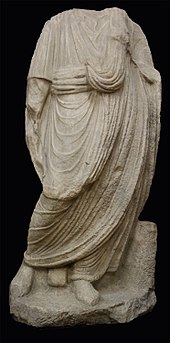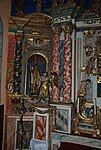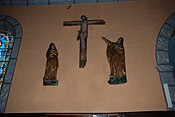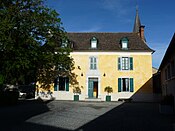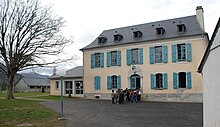Lézignan
| Lézignan | ||
|---|---|---|

|
|
|
| region | Occitania | |
| Department | Hautes-Pyrénées | |
| Arrondissement | Argelès-Gazost | |
| Canton | Lourdes-2 | |
| Community association | Agglomération Tarbes-Lourdes-Pyrénées | |
| Coordinates | 43 ° 6 ′ N , 0 ° 0 ′ W | |
| height | 398-602 m | |
| surface | 2.56 km 2 | |
| Residents | 350 (January 1, 2017) | |
| Population density | 137 inhabitants / km 2 | |
| Post Code | 65100 | |
| INSEE code | 65271 | |
 View of the center of Lézignan |
||
Lézignan is a French commune with 350 inhabitants (as of January 1, 2017) in the Hautes-Pyrénées department in the Occitanie region (before 2016: Midi-Pyrénées ). The municipality belongs to the Argelès-Gazost arrondissement and the Lourdes-2 canton (until 2015: Lourdes-Est canton ).
The inhabitants are called Lézignanais and Lézignanaises .
geography
Lézignan is located about four kilometers east of Lourdes in its catchment area ( Aire urbaine ) in the historic county of Bigorre .
Lézignan is surrounded by the six neighboring municipalities:
| Julos | Bourréac | |
| Lourdes |

|
Arcizac-ez-Angles |
| Jarret | Les Angles |
Lézignan lies in the catchment area of the Adour River .
The Rieutort, a tributary of the Gave de Pau , crosses the territory of the municipality as does the Ruisseau des Graves, a tributary of the Échez .
history
In 1846 a farmer named Pruède found a 1.60 meter tall marble statue without a head on his field at the place with the field name Sendac, along with other finds that have now disappeared. It is ascribed to the first century AD. It is headless, but it has the device that a head can be put on. The statue is thought to have adorned a villa in Gallo-Roman times , so that the theory is underlined that the name of the community is derived from a proper name Lucinius . It is related to the Roman road from today's Toulouse to today's Dax , which passed here. It is believed that the statue belonged to a large tomb. However, the place of discovery is completely unknown today. The statue itself is in the Massey Museum in Tarbes .
Toponymy
The Occitan name of the community is Lesinhan. It comes from the Latin proper name Lucinius together with the suffix -anum , the name for the "Lucinius estate".
Toponyms and mentions of Lézignan were:
- De Lezinhano (1313, Tax List Debita regi Navarre ),
- De Lesignaa (1342, parish register in Tarbes),
- de Lesinhano (1379, Prokuration Tarbes),
- Lesinhan (1429, census in Bigorre),
- Lesinha (1541, Archives of the Pyrénées-Atlantiques Department B1010),
- Lezignaa (1760, Larcher, Church Register in Tarbes).
- Lesignan (1750 and 1793, map by Cassini or Notice Communale ),
- Leusignan (1801, Bulletin des lois ).
Population development
After records began, the population rose to a high of around 435 by the middle of the 19th century. In the period that followed, the size of the community fell to its lowest level with around 215 inhabitants, with brief recovery phases by the 1950s. This was followed by a phase with at times strong growth up to the 1990s, when the number of residents rose to around 430. Since then, the population has been shrinking to this day.
| year | 1962 | 1968 | 1975 | 1982 | 1990 | 1999 | 2006 | 2011 | 2017 |
|---|---|---|---|---|---|---|---|---|---|
| Residents | 241 | 244 | 329 | 383 | 431 | 390 | 370 | 373 | 350 |
Attractions
Parish Church de la Toussaint (Church of All Saints)
The church, consecrated to the Apostle Peter in earlier times , was built at the end of the 17th century. In the 19th century, it was largely rebuilt as a measure after the earthquake of 1854, which particularly affected the bell tower . The vestibule from the end of the 17th century allows the entrance to the interior of the church via tombstones on the floor.
Many pieces of equipment are inscribed as Monument historique :
- the main altar with altarpiece , tabernacle and an adoring angel as a statue from the 18th century,
- two statues made of plaster and terracotta from the early 19th century with the representations of Mary and Joseph ,
- the side altar, consecrated to Saint Martin , called Saint-Blaise, with a retable from the 18th century,
- the wooden paneling of the choir from the 18th century,
- the side altar of the Pietà with retable from the 18th century and
- a Calvaire from the 18th century with Mary and the Evangelist Johannes .
Bigorre style houses
Many houses have been preserved in the center of the community, including the mayor's office ( Mairie ) in the style typical of the area. Wrought iron gates that close off a courtyard are distinctive features.
Economy and Infrastructure
Lézignan is located in the AOC zones of the Porc noir de Bigorre pig breed and the Jambon noir de Bigorre ham .

total = 10
education
The municipality has a public preschool and elementary school with 73 pupils in the 2019/2020 school year.
traffic
Lézignan is crossed by Route départementale 7.
Personalities
Jean-Marie Barthe, born on April 8, 1849 in Lézignan, died on November 11, 1934 in Shembaganur near Kodaikanal ( India ), was a Jesuit missionary and bishop of Tiruchirappalli .
Web links
Individual evidence
- ↑ Hautes-Pyrénées ( fr ) habitants.fr. Retrieved November 27, 2019.
- ↑ Aire urbaine de Lourdes (242) ( fr ) INSEE . Retrieved November 27, 2019.
- ↑ Ma commune: Lézignan ( fr ) Système d'Information sur l'Eau du Bassin Adour Garonne. Retrieved November 27, 2019.
- ↑ La statue gallo-romaine de Lézignan ( fr ) loucrup65.fr. Retrieved November 27, 2019.
- ↑ Lézignan ( fr ) Hautes-Pyrénées department. Retrieved November 27, 2019.
- ^ David Rumsey Historical Map Collection France 1750 ( en ) David Rumsey Map Collection: Cartography Associates. Retrieved November 27, 2019.
- ↑ a b Notice Communale Lézignan ( fr ) EHESS . Retrieved November 27, 2019.
- ↑ Populations légales 2016 Commune de Lézignan (65271) ( fr ) INSEE . Retrieved November 27, 2019.
- ↑ Lézignan ( fr ) Patrimoines Lourdes Gavarnie. Retrieved November 27, 2019.
- ↑ église de la Toussaint ( fr ) French Ministry of Culture . Retrieved November 27, 2019.
- ↑ Institut national de l'origine et de la qualité: Rechercher un produit ( fr ) Institut national de l'origine et de la qualité . Retrieved November 27, 2019.
- ↑ Caractéristiques des établissements en 2015 Commune de Lézignan (65271) ( fr ) INSEE . Retrieved November 27, 2019.
- ^ École maternelle et élémentaire ( fr ) National Ministry of Education. Retrieved November 27, 2019.
- ^ Bishop Jean-Marie Barthe, SJ ( en ) catholic-hierarchy.org. Retrieved November 27, 2019.

